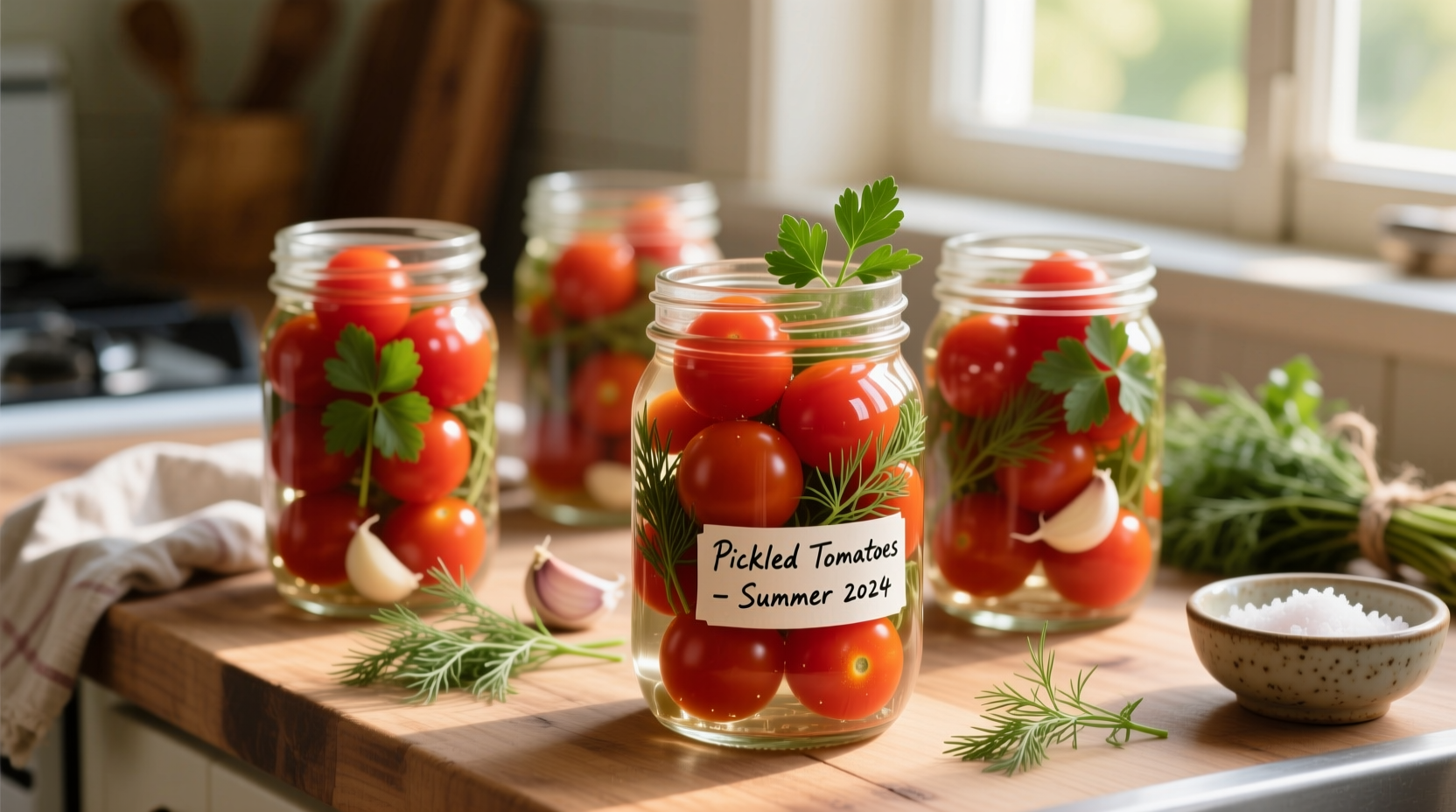Pickled tomatoes are fresh tomatoes preserved in an acidic brine solution typically made with vinegar, salt, and spices. When properly prepared using tested methods, they maintain a firm texture while absorbing complex flavors, offering a shelf-stable pantry staple that lasts 12-18 months when canned correctly. This guide provides science-backed techniques for safe, flavorful pickled tomatoes anyone can make at home.
The Essential Guide to Perfect Pickled Tomatoes
Why Pickling Transforms Tomatoes
Unlike canned tomatoes that break down during processing, pickling preserves tomatoes' firm structure through acidification. The National Center for Home Food Preservation confirms that a minimum 5% acidity level (pH below 4.6) prevents dangerous bacterial growth while maintaining texture. This chemical process creates that distinctive tangy crunch that makes pickled tomatoes invaluable in Mediterranean salads, charcuterie boards, and cocktail garnishes.
Finding Your Perfect Tomato Match
Not all tomatoes respond equally to pickling. The firmness and size characteristics determine success:
| Tomato Variety | Best For | Texture After Pickling | Processing Tip |
|---|---|---|---|
| Cherry Tomatoes | Whole pickling | Firm with burst texture | Pierce skins before processing |
| Roma/Plum | Sliced applications | Holds shape well | Peel for cleaner appearance |
| Green Tomatoes | Traditional recipes | Crisp, firm texture | Use within 7 days of harvest |
| Vine-Ripened | Flavor-focused uses | Softer consistency | Shorter processing time |
According to USDA Complete Guide to Home Canning, cherry tomatoes under 1 inch in diameter work best for whole pickling because they absorb brine more evenly. Larger varieties require quartering to ensure proper acid penetration.
The Evolution of Tomato Pickling Methods
Tomato preservation has evolved significantly since tomatoes arrived in Europe from the Americas:
- 16th Century: Early European preservation used wine vinegar and mustard seeds (documented in Bartolomeo Scappi's 1570 cookbook)
- 19th Century: Commercial canning emerged with salt brine methods before vinegar-based recipes dominated
- 1943: USDA published first standardized pickling guidelines during WWII food conservation efforts
- Modern Era: Research at UC Davis confirmed optimal vinegar ratios for safety and flavor balance
Creating Your Brine: The Science of Flavor Balance
The perfect brine maintains safety while developing complex flavors. Research from the National Center for Home Food Preservation shows these ratios produce consistently safe results:
- Basic Ratio: 1 part 5% acidity vinegar to 1 part water (never reduce vinegar)
- Salt: 1½ tablespoons canning salt per quart (iodized salt causes cloudiness)
- Sugar: 1-2 tablespoons per quart (adjust to taste, doesn't affect safety)
For enhanced flavor complexity, add spices in these proportions:
- 2-3 garlic cloves per pint jar
- ½ teaspoon mustard seeds
- ¼ teaspoon red pepper flakes (adjust to heat preference)
- 1 bay leaf per quart

Avoiding Common Pickling Pitfalls
Even experienced home preservers encounter these issues. Understanding the why helps prevent failures:
Cloudy Brine
Cause: Using table salt with anti-caking agents or hard water
Solution: Switch to pure canning salt and filtered water
Mushy Tomatoes
Cause: Overprocessing or using overripe tomatoes
Solution: Process pints for exactly 15 minutes at boiling water bath (verified by USDA guidelines)
Weak Flavor
Cause: Insufficient spice contact time
Solution: Let jars sit 4-6 weeks before opening to allow flavors to develop fully
When Pickled Tomatoes Shine (And When They Don't)
Understanding context boundaries ensures optimal usage:
- Perfect For: Mediterranean grain bowls, Bloody Mary cocktails, antipasto platters, and as pizza toppings
- Limited Use: Avoid in cooked sauces where texture matters (they'll disintegrate)
- Substitution Tip: Replace olives with pickled cherry tomatoes in salads for less sodium
- Flavor Pairing: Complement with feta cheese, fresh basil, and good olive oil
Step-by-Step Pickling Process
Follow this verified method for guaranteed success:
- Wash 2 lbs firm tomatoes (cherry or quartered larger varieties)
- Prepare jars by sterilizing in boiling water for 10 minutes
- Create brine: Combine 2 cups vinegar, 2 cups water, 3 tbsp salt, and spices in non-reactive pot
- Bring brine to rolling boil, then pour over tomatoes in jars leaving ½ inch headspace
- Remove air bubbles with non-metallic utensil
- Wipe rims, apply lids, and process in boiling water bath: 15 minutes for pints, 20 for quarts
- Cool undisturbed for 12-24 hours before checking seals
Always follow current USDA guidelines for water bath canning times based on your altitude. The Food Safety and Inspection Service confirms that proper processing destroys harmful microorganisms while maintaining quality.
Storage and Shelf Life Guidelines
Properly processed pickled tomatoes maintain quality for 12-18 months when stored correctly:
- Store in cool, dark place below 70°F (21°C)
- Check seals before each use - discard if lid pops when pressed
- Refrigerate after opening and consume within 3 weeks
- Discard if you notice mold, off-odors, or bulging lids
Remember that home-canned products don't contain preservatives like commercial versions, so always inspect carefully before consumption. The National Center for Home Food Preservation emphasizes that any signs of spoilage mean immediate disposal - don't taste to check!
Expanding Your Pickling Repertoire
Once you've mastered the basics, experiment with these professional variations:
- Mediterranean Style: Add lemon zest, oregano, and Kalamata olives
- Sweet Heat: Include sliced jalapeños and a cinnamon stick
- Herb-Infused: Use fresh rosemary, thyme, and tarragon
- Asian Fusion: Substitute rice vinegar and add star anise
When developing your own variations, maintain the critical 1:1 vinegar-to-water ratio for safety while adjusting other elements to taste. The University of Georgia's food science department confirms that flavor experimentation is safe as long as acidity levels remain consistent.











 浙公网安备
33010002000092号
浙公网安备
33010002000092号 浙B2-20120091-4
浙B2-20120091-4